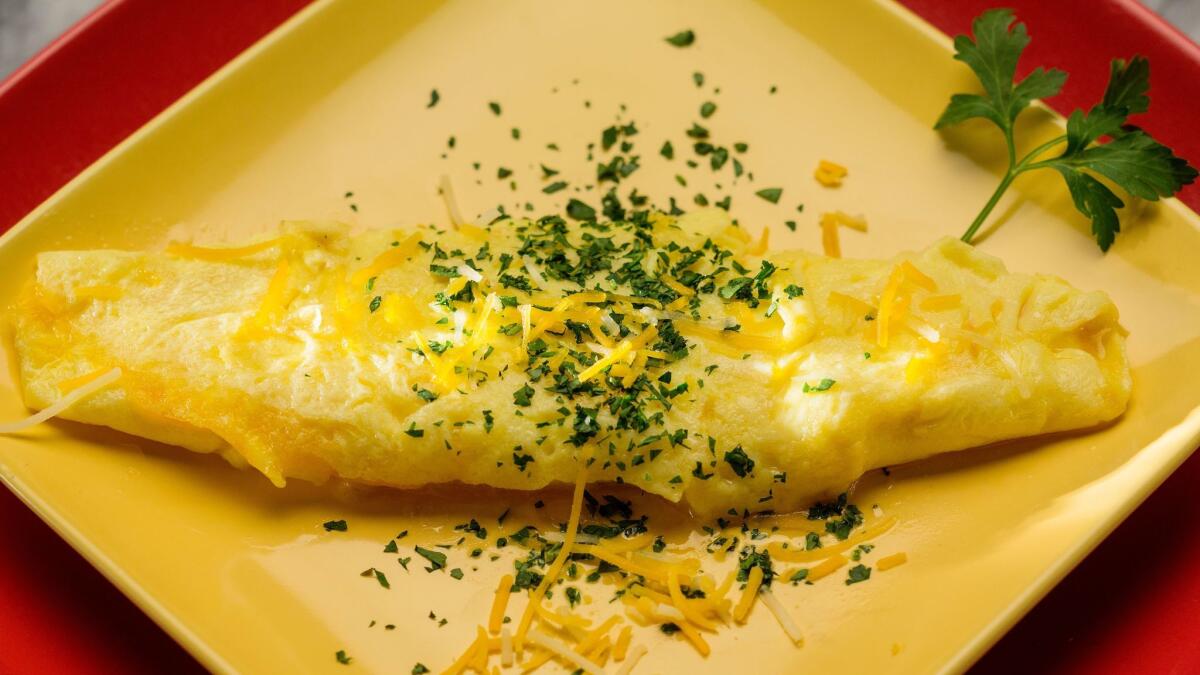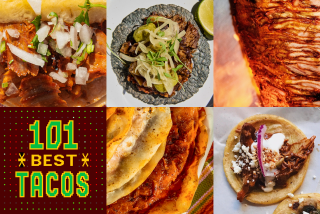Cookbook of the week: âThe Artistsâ and Writersâ Cookbookâ plus the âCoralineâ cheese omelet recipe
A good recipe most often comes with a back story, and in one new cookbook the storytelling is so essential to the cookery that the title would be equally at home displayed on a kitchen counter or atop a stack of novels on a nightstand. With âThe Artistsâ and Writersâ Cookbook: A Collection of Stories With Recipes,â editor Natalie Eve Garrett has compiled a collection of cross-genre literary recipes from more than 70 of todayâs most celebrated writers and artists, including Joyce Carol Oates, Neil Gaiman, Marina AbramoviÄ and L.A.âs own Ed Ruscha.
Garrett, who is an artist and writer herself, was moved to create the book after encountering an obscure 1961 cookbook of the same title, which featured contributions from artists and writers such as Marcel Duchamp and Harper Lee. In Garrettâs contemporary iteration, Pulitzer Prize-winning author Anthony Doerr shares an evocative guide to huckleberry hunting that leads to a recipe for his quintessential summer muffin. Cartoonist and essayist Tim Kreider carefully describes the steps for baking a foolproof pie crust, interspersed within the chronological account of a tortuous love affair, in his âRecipe for Heartbreak.â The street artist known as Swoon recounts the recipe for a ratatouille that she once found solace in after surviving a fierce storm during a Mississippi River crossing.
Among the handful of arguably fictional recipes, Los Angeles writers prove particularly inventive. Aimee Benderâs bleak recipe for stone soup is presented by way of a short story wherein a mother teaches her famished children to cook imaginatively. And if youâve ever cringed at the mention of turducken â Thanksgivingâs trendy bird-within-a-bird dish â T.C. Boyleâs take on the historically eyebrow-raising âBaked Camel (Stuffed)â is likely to provoke a full gasp.
Although the book contains a number of standout recipes, to say nothing of the old standbys (James Francoâs contribution is a homage to the all-American PB&J), when presented on culinary merits alone the recipe index doesnât really tell a cohesive story. Despite tidy categorization into six meal genres â breakfast, soups and salads, sandwiches and pizza, main dishes, snacks, sweets â the recipes vary wildly in levels of difficulty, culinary creativity and even whimsy.
But what makes this book unique is also what makes it a success. The recipes are intimately connected to each artistâs or writerâs short story, poem or essay, and as a result the book tells a collective story about more than just how to prepare food. It tells the story of what it sometimes means to be human: hungry, heartbroken and hopeful. Love can feel as bright as a yellow egg yolk or as fragile and empty as a discarded shell. Fear can sound like bacon sizzling on a hot grill. Memory often feels ethereal, like steam rising from a bowl of pho.
In its own way, an evocative story has as much ability to nourish us as does a hearty meal; with âThe Artistsâ and Writersâ Cookbookâ weâre given the opportunity to be fed in both ways.
Cookbook of the Week: âThe Artistsâ and Writersâ Cookbook: A Collection of Stories With Recipes,â edited by Natalie Eve Garrett (PowerHouse books, $30)

Recipe: Coralineâs cheese omelette Âť
CORALINEâS CHEESE OMELET
10 minutes. Serves 1.
2 eggs
1 tablespoon milk
Pinch salt
About 1 tablespoon butter
2 tablespoons grated cheese, more if desired
Parsley, if desired, for garnish
1. Beat together the eggs, milk and a pinch of salt.
2. Melt a large pat of butter in a frying pan, coat the pan with it, then pour it into the egg mixture and beat it in.
3. Pour the mixture into the pan.
4. Sprinkle grated cheese onto the egg mixture.
5. Push the eggs away from the edges of the pan, letting anything liquid cook. Donât let the bottom of it brown. Fold it in the pan or do the elegant thing where you slip it half onto the plate then let the top half come down on the bottom half. Garnish with fresh parsley or donât, depending on the finickiness of whoever you are feeding and whether they are scared of parsley.
Each serving: Calories 311; Protein 16 grams; Carbohydrates 2 grams; Fiber 0; Fat 26 grams; Saturated fat 13 grams; Cholesterol 418 mg; Sugar 1 gram; Sodium 382 mg
Note: Adapted from a recipe by Neil Gaiman in âThe Artistsâ and Writersâ Cookbook.â
More to Read
Eat your way across L.A.
Get our weekly Tasting Notes newsletter for reviews, news and more.
You may occasionally receive promotional content from the Los Angeles Times.








